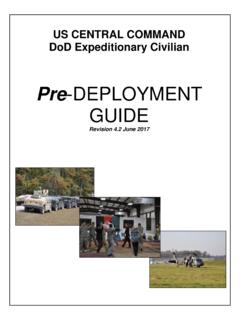Transcription of Energy Toolkit 2 - Worldwatch Institute
1 Energy Toolkit Leading Instruments and Methodologies for Sustainable Energy Planning November 2016. Energy Toolkit Leading Instruments and Methodologies for Sustainable Energy Planning The second iteration of the Energy Toolkit , a collection of leading instruments and methodologies for climate-compatible Energy planning, offers Energy practitioners, policymakers, and experts a quick reference guide to some of the best-established instruments available at no or low cost. The result is a compilation of 25 tools from agencies around the world.
2 The Toolkit was produced as a team effort with the many members of the Low- Emissions Development Strategies Global Partnership (LEDS GP), in particular its Energy Working Group (LEDS EWG). The LEDS GP was founded in 2011 to facilitate peer learning, technical cooperation, and information exchange to support the formation and implementation of low emission development strategies. It has a focus on supporting developing countries and regions. It engages leaders from over 300. institutions across government agencies, technical institutes, international agencies, and non-governmental organizations.
3 The LEDS EWG promotes sustainable and climate-compatible development in the Energy sector through a work program focused on peer-to-peer learning, technical assistance, and enhanced opportunities for coordination and collaboration between LEDS GP members. The LEDS EWG also produces supporting materials, such as best-case studies or reference guides like the one presented here. This Toolkit does not claim to be a complete encyclopedia of all available tools. We hope to update and further improve the Toolkit in coming years. If you have developed a sustainable Energy modelling tool or know of one that should be featured here, please contact us at Thank you!
4 We hope this Toolkit will help you to make Energy fairer, safer, and greener for all. Alexander Ochs | Lead Editor Director of Climate and Energy , Worldwatch Institute | LEDS EWG Chair Philip Killeen | Co-editor, Version Research Associate, Worldwatch Institute | LEDS EWG Secretariat Manager Max Lander | Co-editor, Version Former Research Assistant, Worldwatch Institute LEDS Energy Working Group and Worldwatch Institute 2016. Acknowledgements The authors thank the Department of Energy for their support of the LEDS. GP which allowed us to work on this Toolkit .
5 We would also like to thank the National Renewable Energy Laboratory (NREL) for being invaluable supporters of our work in their role of managing the LEDS GP Secretariat. Production of this LEDS Energy Toolkit would also not have been possible without the participation and assistance of our broad and growing network of partners in the LEDS Energy Working Group. Our sincere gratitude goes to all tool designers and stewards who graciously contributed profiles of their product; to the leads and EWG co-chairs from the LEDS GP regional platforms in Africa, Asia, and Latin America and the Caribbean who advised the editors on defining issue-areas of highest need to LEDS GP.
6 Member countries and thereby helping to identify the most useful tools; to Ana Rojas of the IUCN Global Gender Office who provided support on identifying effective gender methodologies. We also like to thank our colleagues Gaelle Gourmelon for helping with design, outreach, and public relations, as well as Lisa Mastny for line editing. Contents Cost and Benefit 1 Gender Inclusion 31. CREST | Cost of Renewable Energy Mainstreaming Gender in Energy Spreadsheet Tool 2 Projects: A Practical Handbook 32. META | Model for Electricity Guidelines on Renewable Energy Technology Assessment 4 Technologies for Women in Rural JEDI | Jobs and Economic and Informal Urban Areas 34.
7 Development Impact Models 6. Geospatial Resource Demand and Energy Assessment 36. Efficiency 8 RED-E | Renewable Energy Data EnergyPlus | Building Energy Explorer 37. Simulation Program 9. MAED | Model for Analysis of Integrated Tools 39. Energy Demand 11 Balmorel | Energy System Model 40. OpenStudio | Module for Whole GCAM | Global Change Assessment Building Energy Modeling Model 42. Application Development 13 HOMER | Hybrid Optimization of TRACE | Tool for Rapid Assessment Multiple Energy Resources 44. of City Energy 15 ISED | Indicators for Sustainable Energy Development 46.
8 Environmental Impact LEAP | Long Range Energy Assessment 17 Alternatives Planning System 48. EFFECT | Energy Forecasting RETS creen | Clean Energy Framework and Emissions Management Software 50. Consensus Tool 18 SAM | System Advisor Model 52. HEAT+ | Harmonized Emissions SERIP | Sustainable Energy Analysis Tool Plus 20 Roadmaps and Implementation Plan MESSAGE | Model for Energy 54. Supply Strategy Alternatives and their TIMES | The Integrated General Environmental Impacts 22 MARKAL/EFOM System 56. SIMPACTS | Simplified Approach for WASP | Wien Automatic System Estimating Environmental Impacts of Planning Package 58.
9 Electricity Generation 24. Financial Investment 26. DREI | Derisking Renewable Energy Investment Framework 27. FINPLAN | Financial Analysis of Electric Sector Expansion Plans 29. COST AND BENEFIT. 1. CREST. Cost of Renewable Energy Spreadsheet Tool User-friendly cost of Energy calculator for solar, wind, geothermal, biomass, and fuel cell projects Typical Clients Policymakers Regulators Researchers Beginning developers and financiers Associated Costs Free Current and Past Users Government of Rhode Island Apex Consulting VenLogic More Information content/crest-cost- Energy - models Contact Information Travis Lowder, Energy Analyst 2.
10 CREST | Cost of Renewable Energy Spreadsheet Tool What is it? Outcomes An Excel-based cost of Energy and pro Year one cost of Energy forma model to perform back-of-the- Cash flows over project lifetime envelope calculations for wind, solar, Pro forma analysis geothermal, biomass, and fuel cell projects. CREST can also be used by governments to set feed-in tariff rates and other incentive levels. Key Goals CREST assists policymakers in the design of cost-based incentives to support renewable Energy development in their jurisdictions. Data Inputs Project data (including size, expected performance, and capital costs).








